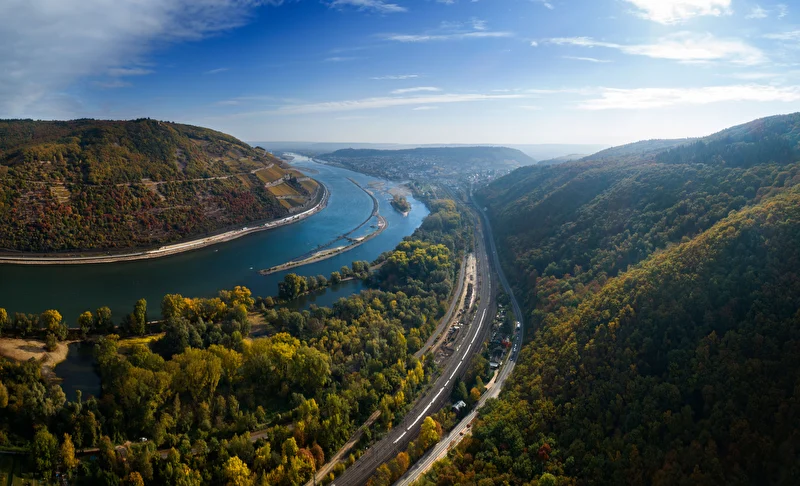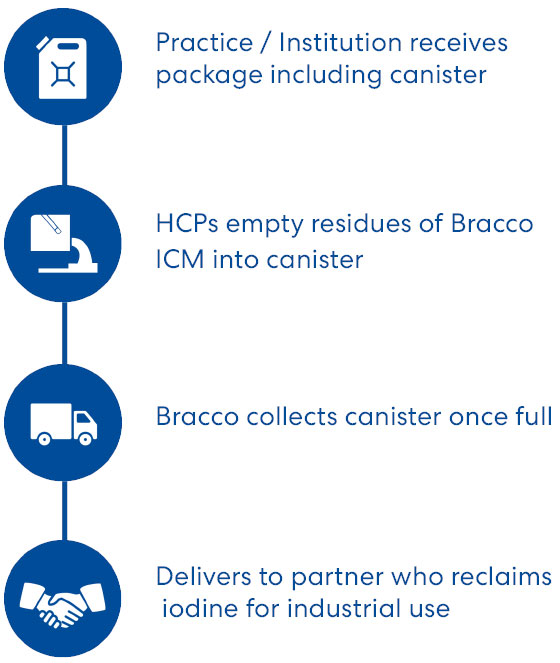Our New Iodine Recollection Pilot and Re.Viva

Closing the Loop
In our sustainability communications we challenge ourselves and the healthcare communities we serve to ‘see the full picture.’ For us as a leader in diagnostic imaging, it is also a challenge to scrutinize our own value chain from beginning to end.
To help close the loop on waste reduction at the very end of this chain, we have recently been working on a pilot project to collect leftover iodinated contrast media (ICM) in Germany. This project falls under the broader banner of an initiative called “Re.Viva” that works to capture and redeploy used substances in the positive momentum of the circular economy.
Responsibility to healthcare,
mankind and the planet
For companies like ours, Iodine is mostly used for the production of non-toxic radiocontrast material that enables healthcare providers in radiology to unlock the inner workings of the human body. The responsible use and management of this valuable substance is important for two main reasons:
- Iodine is a scarce and limited resource.
- There is a case to be made for reducing traces of ICM in surface waters.
We already have state-of-the-art systems in each of our production sites dedicated to the recovery of iodine, and therefore to the reduction of residual iodine entering into the wastewater. However, given the importance of responsible management to our healthcare partners, mankind and the planet, we have worked to plug a gap at the very end of our value chain by collecting leftover ICM.
Iodine recollection pilot program
“This year we introduced a pilot program in Germany that allows HCPs to dispose of the leftover ICM from the application of Imeron/Iomeron (iomeprol) and Solutrast (iopamidol).

The iodine recollection pilot program, introduced in Germany, allows HCPs to dispose of the leftover ICM from the application of Imeron/Iomeron (iomeprol) and Solutrast (iopamidol) into a special Bracco container that we collect. The collected contrast media is then taken to a third-party partner who processes it to extract the iodine. Reclaimed iodine is then directed on for industrial usage.
The recollection system which works with the co-operation of our partners, allows for the reuse of iodine as a finite trace element, as well as limiting ICMs impact on water systems and the broader environment. It will eventually be rolled out globally and possibly expanded to include the separate collection of Gadolinium-based media.
Introducing Re.Viva:
Giving New Strength to Circular Sustainability
The new iodine recollection project is just one of several that falls underneath a broader umbrella initiative we have named Re.Viva. Re.Viva will house all of our projects that focus on the restoration, reuse, or recycling of substances and materials. In other words, it is an initiative devoted to our interests and innovations within the circular healthcare economy.
The new iodine recollection project falls underneath a broader initiative called ‘Re.Viva’ that is devoted to our interests and innovations within the circular healthcare economy.
The circular economy aims to tackles environmental sustainability by decoupling economic activity from the consumption of finite resources. Using this model, we are working towards eliminating or greatly reducing waste and feeding it back into the system to be used repeatedly in a virtuous cycle. We already have several examples of this in action ranging from iodine and solvent recovery, to the retrieval of paper and cardboard, and the reuse of undamaged iopamidol and iomeprol drums.
The intention with Re.Viva however, is not just to focus on what we have already done, but to put new energy behind innovations that will drive this positive momentum forward.
Conclusion: Renewing Purpose
The name Re.Viva was created from word play relating to the celebration of life or the ‘giving of new strength or energy to something.’ With our new iodine recollection program and circular pipeline projects under Re.Viva, we hope to continue renewing purpose for substances and materials that would otherwise have gone to waste.
